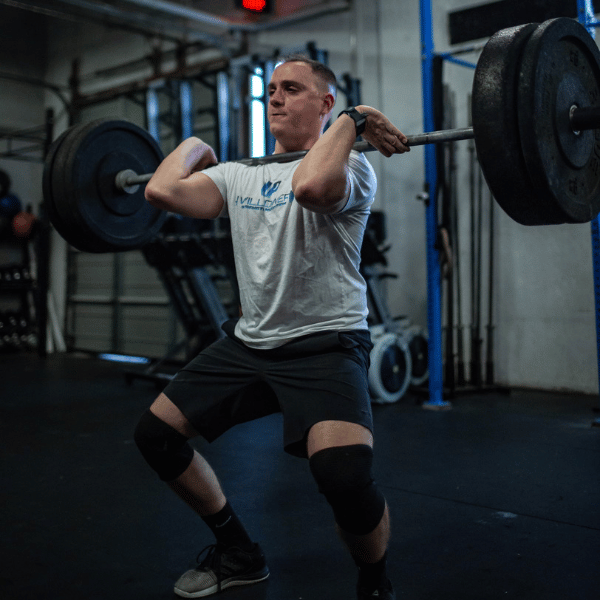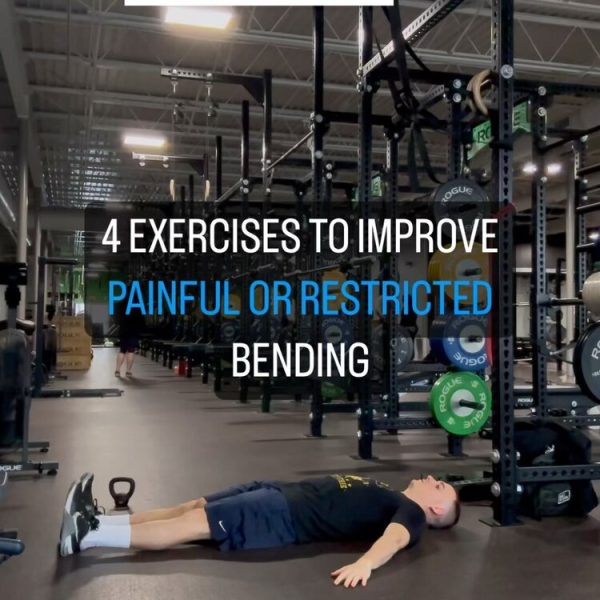Dr. Will Murtagh is a performance physical therapist and writer who helps Fitness Athletes elevate their fitness and train pain-free.
The clean is the strongest Olympic lift that you can do. It perfectly combines many qualities you aim to improve as a CrossFitter, including strength, coordination, balance, and power.
Mastering the clean is one of the most significant factors in CrossFit performance since it is one of the sport’s most frequently trained and tested movements.
But there are also several different variations of the clean. The main variations are the squat clean and the power clean. It is common to confuse these two variations and although they are both “cleans” they are pretty different from one another.
This article will explore the differences between the squat clean and the power clean, discuss their techniques, and review common mistakes and programming considerations for each so that you can easily master them and take your CrossFit performance to the next level.
What Is The Difference Between A Squat Clean vs Power Clean?
The main difference between a squat clean and a power clean is how far down into a deep squat position you are permitted to receive the barbell. Although both clean variations require tremendous amounts of coordination and explosive power, the power clean requires faster speed as there is a shorter range of motion to operate into dropping under the barbell into the receiving position.
During the squat clean, you don’t have to pull the barbell as high. As long as you are fast enough to get under the bar, you can rely on your leg strength to front squat the barbell up to the finish position.
Squat Clean Technique
How To Perform a Squat Clean:
Starting position:
- Stand with your feet just outside your hips at shoulder width apart and point your toes slightly outwards.
- Stand under the barbell with the barbell crossing over the midfoot so that the laces of your show are seen on both sides.
- Bend over and grip the barbell with an overhand grip, just outside the shoulder and wide enough so that the arms do not touch the thighs.
- Ideally, assume a “hook grip.”
Initiating the lift:
- Bring your hips down and pull your chest up so that you assume a deadlift position.
- Maintain a neutral spine with the core braced.
- Pull up on the barbell by activating the latissumus dorsi muscles so that the slack is removed.
- Arms remain fully extended.
First Pull:
- Lift the bar off the ground by simultaneously driving your feet into the ground and extending the hips and knees.
- The chest and hips should rise at the same rate.
- Maintain proximity to the barbell by engaging the lat muscles.
Second Pull:
- Once the barbell passes the knees, pull back on it to ascend it up your thighs and “scoop” the legs under it to assume the power position.
- The chest should continue to rise as you scoop under the barbell and reach the hip crease.
Third Pull:
- Rapidly extend the hips, knees, and ankles, reaching triple extension of the lower body.
- Release tension on the barbell with the arms and allow the barbell to become weightless from the energy produced by the hips.
The Catch:
- Drop under the barbell as quickly as you can and receive the barbell in the catch position as you descend to a full squat.
- Allow the lower body to decelerate the barbell and use the recoil of the muscles to reverse direction out of the deep squat position.
The Finish:
- Using the energy from the catch position, drive the barbell up using the legs to complete the front squat.
- Continue standing until the hips, knees, and ankles return to standing.
Power Clean Technique
How To Perform a Power Clean:
Starting position:
- Stand with your feet just outside your hips at shoulder width apart and point your toes slightly outwards.
- Stand under the barbell with the barbell crossing over the midfoot so that the laces of your show are seen on both sides.
- Bend over and grip the barbell with an overhand grip, just outside the shoulder and wide enough so that the arms do not touch the thighs.
- Ideally, assume a “hook grip.”
Initiating the lift:
- Bring your hips down and pull your chest up so that you assume a deadlift position.
- Maintain a neutral spine with the core braced.
- Pull up on the barbell by activating the latissumus dorsi muscles so that the slack is removed.
- Arms remain fully extended.
First Pull:
- Lift the bar off the ground by simultaneously driving your feet into the ground and extending the hips and knees.
- The chest and hips should rise at the same rate.
- Maintain proximity to the barbell by engaging the lat muscles.
Second Pull:
- Once the barbell passes the knees, pull back on it to ascend it up your thighs and “scoop” the legs under it to assume the power position.
- The chest should continue to rise as you scoop under the barbell and reach the hip crease.
Third Pull:
- Rapidly extend the hips, knees, and ankles, reaching triple extension of the lower body.
- Release tension on the barbell with the arms and allow the barbell to become weightless from the energy produced by the hips.
The Catch:
- Drop under the barbell as quickly as you can and receive the barbell on the shoulders in a front rack position above a parallel squat.
The Finish:
- Using the core and leg muscles, rapidly decelerate the bar and stand to full extension.
The Strength Continuum Explained
The strength continuum is an important concept for all Olympic Weightlifters to be aware of, whether they are training CrossFit or just the traditional Olympic Weightlifting movements such as the clean and snatch. This is because it classifies the different types of strength as they pertain to speed of movement.
Speed and strength have an inverse relationship; as a movement becomes faster, the force applied must be reduced, and vice versa. (1) For example, a back squat at heavier loads will always be slower than a power snatch since the power snatch is done at a lighter load and, therefore, can be moved faster. But, conversely, you will never be able to snatch as heavy as you can back squat.
This may seem obvious, but this fact is important because each type of strength plays a part in your athletic performance, whether that’s in a CrossFit competition, on the weightlifting platform, or on a football field.
If you are stronger than you are fast, then you need more explosive movement in your training program, and if you are faster than you are strong, then you need more dedicated strength training.
Below is an outline of the strength continuum.
Absolute strength: Maximal force production and low-speed exercises such as back squats, deadlifts, and bench presses.
Strength speed: Higher levels of force and lower speed, such as the leading Olympic lifts such as cleans and snatches at relatively heavy loads.
Speed strength: Higher levels of speed and lower levels of force, such as medicine ball tosses or plyometrics.
Absolute speed: The lowest amount of force and the maximum speed, such as sprinting.
Benchmark Strength Levels For Squat Clean vs Power Clean
There are two different benchmarks to shoot for both variations of cleans. One is based on the total amount of weight you should be able to lift based on your body weight, and the other is based on a reference lift to achieve structural balance throughout your body.
Structural balance is the balance in strength between the sides and opposing movements of your body, such as front and back and hinge vs squat movements.
For a total amount of weight to be lifted based on your body weight, you should shoot 1.6 times your body weight for the squat clean and 1.4 times your body weight for the power clean.
For structural balance, you should aim for the squat clean equal to your front squat one repetition maximum and eighty percent of your back squat one repetition maximum. The power clean should equal your close grip bench press one repetition maximum and seventy percent of your back squat one repetition maximum.
Advantages & Disadvantages of Each
Squat Clean Advantages & Disadvantages
Both variations of the clean are excellent exercises to train explosive strength and build up the capacity of your posterior chain. However, the squat clean exercise has the added benefit of enhancing full-body coordination and building a tremendous amount of lower-body strength because of the additional squat movement and the ability to use heavier weights.
The biggest disadvantage of squat clean is that it has a higher learning curve, and athletes may only partially benefit from it as they learn to drop under the barbell and into the squat position with confidence and proper form.
Rather than simply exploding the barbell up to the shoulders like the power clean, extending the hips and rapidly dropping under the bar takes more coordination without fear of receiving the barbell.
For CrossFit, this is an essential movement to learn, but for sports athletes, the time it takes to learn how to squat clean may be better spent on other tasks.
Power Clean Advantages & Disadvantages
The significant advantage of the power clean over the squat clean is that it is easier to learn since there is no additional squat movement to incorporate. It is a more straightforward motion, and athletes can focus on being as explosive as possible by pulling the bar off the floor and catching it on their shoulders.
Since less distance is available to catch the bar, the power clean can lend itself to a more explosive hip drive for better power training and better results over time.
The major disadvantage is that the power clean is predominantly a hinging exercise and does not incorporate any squatting action, so you miss out on the squat strength improvements.
Programming Considerations for CrossFit
CrossFit programming considerations for the two variations of the clean exercise mainly come down to the stimulus you want to achieve. Squat cleans in a CrossFit workout will emphasize muscle endurance of the quadriceps and lower body since there will be a squat movement with each repetition.
Thus, they must lend themselves better to faster-paced metcons since the movement takes longer and is more taxing.
On the other hand, power cleans will typically involve lighter loads. They will be used more frequently in barbell cycling workouts, where several repetitions are performed simultaneously without dropping the barbell.
Power cleans in a CrossFit workout lend themselves better to faster-paced metcons since they can be cycled faster but will typically tax the lower back more quickly than the squat clean since it emphasizes the hinge position.
On average in CrossFit, squat cleans are better for metcons with heavier loads where single repetitions are done, and power cleans fit more nicely into traditional metcons and barbell cycling. But in the true nature of CrossFit, there are no rules, and you should prepare for everything.
Common Mistakes For Squat Clean vs Power Clean
Foot Width Too Wide
Starting with feet too wide can reduce the amount of power you generate and alter the mechanics of the arms if they rub up against your things or are over the knees. Keep your stance to a width from which you would perform a jump.
Allowing A Rounded Spine
You want your spine to be strong in all positions, but this is different in Olympic Lifting. A stable and neutral spine will help keep the back pain-free and help transfer force from the lower body into the barbell. (2)
Early Arm Bending
Bending the arms before the hips extend entirely is a very common mistake and one that I make myself from time to time. Although it can be tempting to do so, it is best to keep the elbows extended to maximize the power generated by the barbell from the hips.
Think of your arms as nothing more than hooks that only bend as a result of the barbell elevating after the third pull and pulling yourself under the bar.
Starfishing The Power Clean
This is common if you need more confidence and speed under the barbell. A starfish catch occurs when the feet move laterally after the third pull to drop your center of mass under the bar. But this is compensation for not pulling yourself under the bar and dropping into a quarter squat. You can fix this by practicing the catch with lighter loads.
Rushing The Third Pull
It can be tempting to initiate the third pull before the barbell reaches the power position. This looks like extending the hips and the barbell, making contact low on the thighs rather than the middle or upper thigh. An early third pull typically happens when you rush to extend the hips when the weight is heavy or you are impatient.
It is only about an inch, but waiting an extra second to continue pulling the barbell up the thigh can mean the difference between making the lift and missing it.
Final Thoughts On The Squat Clean vs Power Clean
Understanding the nuances and proper technique of the squat clean and power clean variation is crucial for anyone starting their CrossFit journey. Both methods offer a tremendous amount of benefit in their own right to build overall strength and explosive power.
While the squat clean can optimize strength and coordination, the power clean can enhance power and is well suited for metabolic conditioning. By understanding these differences, you can fine-tune your technique for each lift and make strides in your CrossFit performance.
The concepts I have reviewed above are the same ones I coach my clients on inside my 1:1 Pain-Free Performance Program. I help CrossFit athletes reach new fitness levels in CrossFit without joint pain.
If you’d like to learn more about how the program can help you, I invite you to click HERE to book a free consultation so that I can learn more about you and your goals!
References:
- National Strength and Conditioning Association (NSCA). (2023). Velocity-based training: From theory to practice [PDF document]. Retrieved March 27, 2024, from https://www.nsca.com/contentassets/7fc346ec744044b6871541e5a6ee5c63/velocity_based_training__from_theory_to.99257.pdf
- Willson, J. D., Dougherty, C. P., Ireland, M. L., & Davis, I. M. (2005). Core stability and its relationship to lower extremity function and injury. The Journal of the American Academy of Orthopaedic Surgeons, 13(5), 316–325. https://doi.org/10.5435/00124635-200509000-00005













